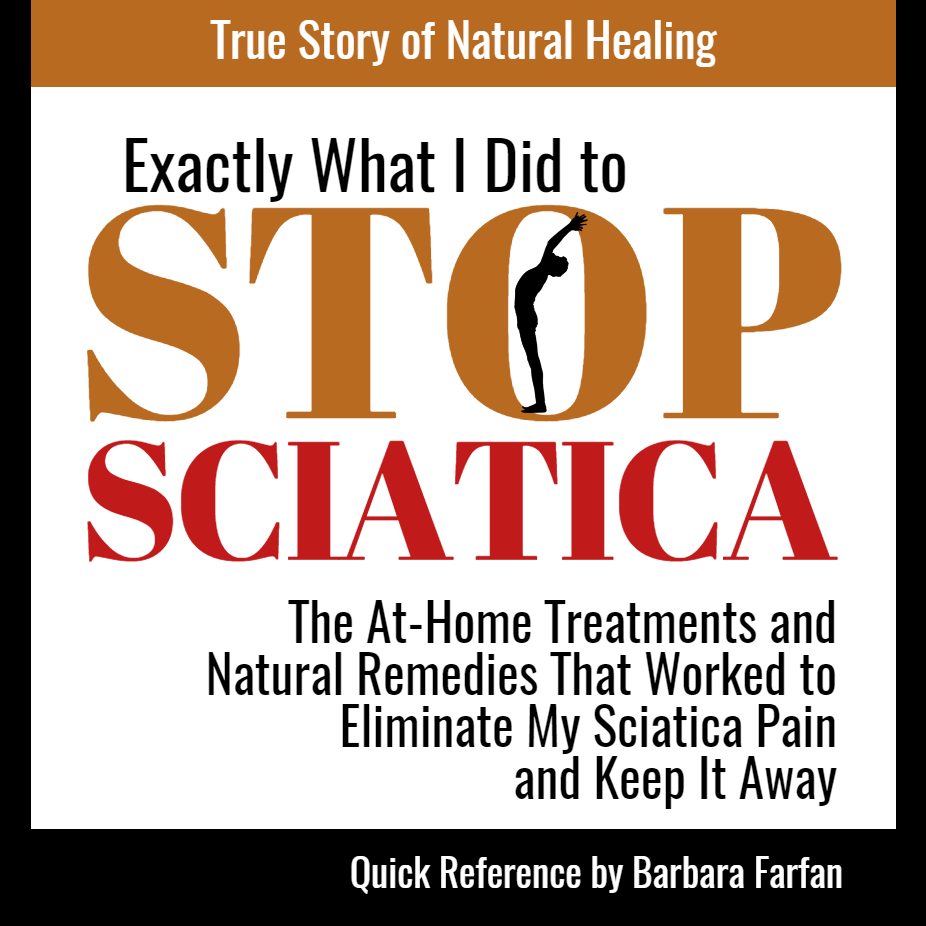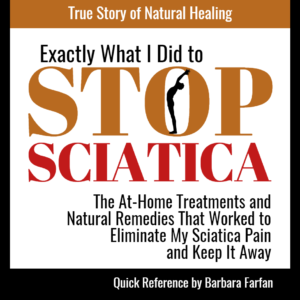1. Complete Inaction Could Cause Long-Term Chronic Sciatica Problems

Do-nothing-and-wait-for-it-to-go-away is actually a workable strategy for many health conditions, but not so with Sciatica. Why not? Because the cause of Sciatica generally does not fix itself over time without any type of intervention.
Something caused compression, pinching, or injury to your sciatic nerve before you felt any Sciatica pain. If the dysfunction of that “something” that caused the sciatic nerve pain isn’t brought back into functional balance, the damage to the sciatic nerve that is causing you pain will not be able to heal. If you do nothing, the cause remains, it might get worse, and your sciatic nerve may be constantly re-injured, re-irritated, re-inflamed, and chronically stay swollen.
Restoring functional balance to the cause of sciatic nerve pain is usually found in the spine and usually can be fixed with non-invasive and natural methods like Chiropractic, Physical Therapy, Osteopathy, or Massage. Only in a small percentage of sciatica cases is surgery necessary.
Whatever course of treatment you choose, choosing to do absolutely nothing can make things worse and cause you long-term chronic problems that could have been prevented with a proper response in the first place.
2. Over-the-Counter or Prescription Medications Can’t Cure Sciatica and Have Bad Side Effects

Masking the pain with over-the-counter or prescription medications may provide temporary relief from sciatica pain, but they won’t eliminate the cause of the sciatic nerve compression, pinching, injury or dysfunction. And unless the cause is eliminated, the sciatic nerve inflammation and swelling can’t heal. And unless the inflammation and swelling heals, the pain won’t stop.
In other words, you can’t change the end of the story until you go back and change what started the story in the first place.
If the cause of the sciatica is not eliminated, sciatic nerve pain will become a chronic and never-ending condition. If masking the pain with prescription drugs is your only strategy, then you will also suffer both the short-term and long-term side effects of using those drugs.
These are the possible side effects you are subjecting yourself to if you choose over-the-counter or prescription drugs to be your sciatica solution, according to WebMD.com and MayoClinic.com.
NSAIDs – (Aspirin, OTC anti-inflammatories) long-term use side effects:
– ulcers
– kidney damage
– blood thinning
– bleeding in the brain
– stroke
NSAIDs possible immediate and short-term use side effects:
– breathing difficulties
– anaphylaxis
– swelling in the face
– itchy skin
– hives
– runny nose
– red eyes
Ibuprofen (Advil)
Even though Ibuprofen is an NSAID, it differs from aspirin. But that doesn’t mean it is free from side effects. Long-term use of Ibuprofen has been proven to have these side effects:
– ulcers
– intestinal bleeding
– kidney damage
– heart attack
– stroke
– blood clotting disorders
– high blood pressure
– liver failure
Ibuprofen also has these possible immediate and short-term use side effects:
– stomach pain
– heartburn
– nausea
– vomiting
– gas
– constipation
– diarrhea
– breathing difficulties
– anaphylaxis
– swelling in the face
– itchy skin
– hives
– runny nose
– red eyes
Acetominophen (Tylenol)
Once thought to be a rather benign medication, long-term use of Acetominophen has been proven to have these side effects:– liver damage
– digestive tract bleeding
– high blood pressure
– heart attack
– stroke
Acetominophen also has these possible immediate and short-term use side effects:
– bloody stools
– bloody urine
– chills
– lower back pain
– rash
– sore throat
– mouth sores, ulcers, or white spots
– bleeding or bruising
– weakness
– yellow skin
– diarrhea
– loss of appetite
– stomach cramps
– abdominal pain, swelling, tenderness
Opioids/Narcotics (Codeine, Hydrocodone, Meperidine, Demerol, Morphine, Oxycodone, Oxycontin, Propoxyphene, Darvon) side effects:
– addiction
– diminished immune system
– suicidal depression
– increased sensitivity to pain
– mood swings and hostility
– insomnia
– respiratory dysfunction
– loss of physical coordination
– brain damage
– memory loss
– vision and hearing loss
– loss of balance and coordination
– confusion
– overdose
– death
Muscle Relaxers (Cyclobenzaprine, Flexeril, carisoprodol, Soma) side effects:
One of the reasons why taking muscle relaxers is a bad idea with Sciatica is because Sciatica pain has nothing to do with the muscles. It is a nerve pain. So while muscle relaxers might make you drowsy and generally numb to everything, it’s a mismatched treatment at best which has these negative side effects:
– addiction
– confusion
– difficulty thinking and reasoning
– impaired motor skills
– drowsiness
– weakness
– dizziness
– depression
– low blood pressure
When you stop taking muscle relaxers, you may experience these side effects mildly to severely:
– insomnia
– vomiting
– anxiety
– uncontrollable craving
In conclusion…
Popping a pill might seem like the best or only choice to alleviate the unbearably intense pain of Sciatica, but the resources the body must use to combat the negative side effects of over-the-counter and prescription medications is energy that it can’t use to heal the source of your Sciatica pain, which is the sciatic nerve itself.
When you take synthetic medications, you are requiring your body’s natural healing forces to fight on many different battlegrounds at the same time, splitting its focus and greatly diminishing its effectiveness. So, your short-term drug band-aid will almost certainly prolong the healing process for your sciatic nerve – sometimes dramatically.
In other words, the longer you choose to mask the pain of Sciatica, the longer the Sciatic Nerve pain may last.
3. Steroid Treatments Won’t Stop Sciatica and Will Have to Be Repeated Frequently

Similar to using pain killers, the use of steroids to treat the inflammation and swelling which causes sciatica pain is not the same as healing the sciatic nerve. Unless the root cause of the sciatic nerve compression, pinching, injury or dysfunction is eliminated, you will need to receive the steroid treatment(s) repeatedly just to temporarily stop the symptoms.
According to WebMd.com and MayClinic.com the possible consequences of long-term steroid use include:
– high blood pressure
– mood swings
– memory loss
– confusion or delirium
– weight gain
– glaucoma
– cataracts
– diabetes
– diminished immune system
– osteoporosis
– chronic fatigue
– muscle weakness
– think skin and bruising
– slow wound healing
– insomnia
4. Surgery Is Risky and Mostly Unnecessary for Most Sciatica Sufferers

According to Harvard Health, 50% of people with sciatica pain get relief within 4 weeks without medical intervention, and less than 5% to 10% of people with sciatic nerve pain ever require back surgery in order to eliminate the root cause of the sciatic nerve pain.
According to the Cleveland Clinic, spinal surgery is usually not recommended unless your sciatic nerve pain has not improved with any other treatment method, the sciatic nerve pain is worsening over time, you develop severe lower extremity muscle weakness, or you experience loss of bladder or bowel control.
Surgery always has inherent risks, which includes uncontrollable bleeding, blood clots, infections, paralysis, brain damage, and death. Specifically, according to the University of Maryland Medical Center, the risks associated with spinal surgery also include:
– nerve damage
– spinal fluid leak
– loss of bladder control
– loss of bowel control
– spinal cord injury
– sexual dysfunction
– more chronic pain than you had before the surgery
5. Unsupervised Movement and Exercise Can Re-injure the Sciatic Nerve

While there is a debate about whether activity or inactivity is the best treatment in the early stages of sciatica, most assuredly you will not remain immobile forever. Actively exercising to alleviate, eliminate, and prevent sciatica pain is a positive choice, but the wrong kind of exercise and movement is not positive. It is important to know which type of movement and exercise will help and which kind of movement and exercise could hurt and further damage your sciatic nerve. According to Healthline.com, there are 10 exercise movements that sciatic pain sufferers should avoid completely:
– Forward bending from a seated or standing position
– The Hurdler Stretch
-,Leg Circles
– Double Leg Lifts
– Revolved Triangle Pose
– Burpees
– Bent-over Rowing
– Squats with Weights
– Bicycling in a forward=bending position (especially on a hard seat)
– High impact sports or aerobic exercises
6. Pushing Through the Pain Isn’t a Successful Sciatica Strategy

“No pain, no gain” is NOT the battle cry for Sciatica!
While gentle stretching, yoga, pilates, and physical therapy can be extremely helpful to sciatica, doing the wrong moves or doing them in the wrong way can actually cause more damage and more pain to your sciatic nerve in both the short-term and the long-term. While it doesn’t seem like it, pain is your friend when it comes to movement and exercise because it tells you that you’re doing something that will hurt, rather than help you.
The general rule to follow is if any type of movement causes pain, stop doing it immediately. This includes sitting, standing, and walking. One size does NOT fit all and every exercise is NOT right for every body or every cause of sciatica. It is best to get some expert guidance from a yoga, pilates, physical therapy, or some other type of rehab exercise practitioner with Sciatic-specific experience.
7. Prolonged Immobilization Accelerates an Immobilized Future

This may seem to be in direct contradiction to the previous two points, but it’s not. While it is important not to aggravate your already damaged sciatic nerve with the wrong kind of movement, staying immobile for too long can also make your sciatica worse or prolong the pain because immobility causes the back to become stiff, weak, and deconditioned. Prolonged inactivity results in a loss of key muscle strength and bone density.
Inactivity, a sedentary lifestyle, and the wrong type of activity is behind the spinal cause of most sciatic nerve functions to begin with. So getting active and increasing your level of activity will ultimately be the fastest path to the elimination of sciatica pain. Don’t get too active too soon, but don’t make things worse by using your sciatica as an excuse to become even more sedentary.
8. Eating Inflammatory Foods Will Prolong Sciata Nerve Irritation

Sciatica develops because the sciatic nerve gets compressed, irritated, or damaged somehow. This causes the entire sciatic nerve to become inflamed and swollen. It’s the inflammation and swelling that cause the unbearable pain. After the source of the compression, irritation or damage is fixed, the inflammation and swelling of the entire sciatic nerve doesn’t spontaneously go away. It can take a long time to heal. And it can take even longer if you’re feeding the inflammation with inflammatory foods.
Unfortunately, “inflammatory foods” are often the same foods that the average American would characterize as “comfort foods.” While comfort foods might seem to make us feel emotionally better when we’re in physical pain, they will actually prolonging the very pain you want to get rid of.
Don’t work against yourself by eating and drinking the things that will increase the inflammation that fuels the pain!
According to WebMD, these are the worst Inflammatory foods to avoid:
– Sugar and anything containing any amount of sugar
– Processed meats
– Fried Foods
– Butter, cheese, trans fats, and omega-6 fats
– Gluten

Even though this is an article about Sciatica Don’ts, if you’re going to stop eating Inflammatory foods (which is a long list), it’s pretty important to know which anti-Inflammatory foods to START eating (which is a shorter list). According to WebMD, these are the best anti-inflammatory foods to eat:
– Fruits and vegetables high in vitamin-K and vitamin-C
– High-fiber whole grains
– Olive Oil
– Avocados
– Nuts
– Omega-3 Fatty Acid Fish
And for an extra anti-inflammatory boost, according to Healthline.com, these are some of the most powerful anti-Inflammatory Herbs and Vitamins to consume:
– Vitamin C
– Vitamin D
– Curcumin/Turmeric
– Ginger
– Garlic
– Green Tea






 Here’s exactly what I did to stop my Sciatica pain and keep it away.
Here’s exactly what I did to stop my Sciatica pain and keep it away.